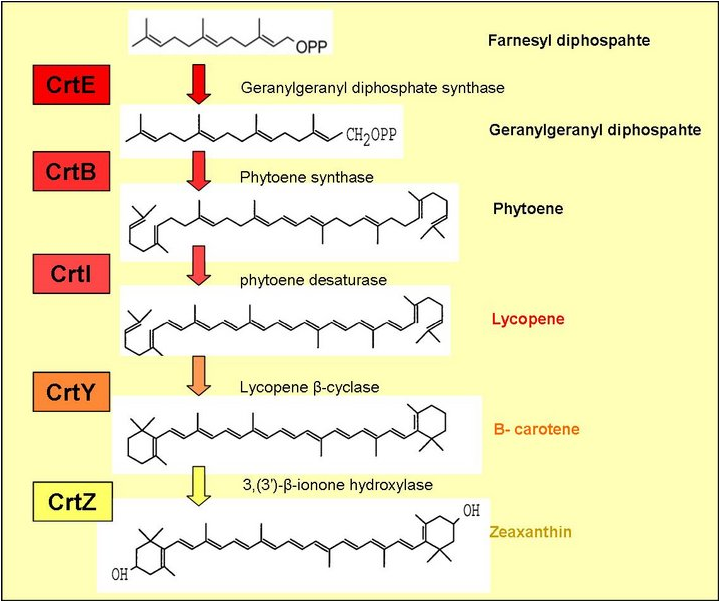Team:WashU/Project
From 2011.igem.org
Abstract
Engineering Carotenoid Biosynthesis in Saccharomyces cerevisiae
Vitamin A deficiency causes blindness in over 250,000 children annually. The WashU iGEM team hopes to address this issue by creating a transgenic strain of Saccharomyces cerevisiae (baker's yeast) that produces beta-carotene, the precursor to vitamin A. The WashU team created four DNA constructs for homologous recombination into the S. cerevisiae genome that will catalyze the production of beta-carotene. Each construct consisted of a gene encoding an enzyme from Xanthophyllomyces dendrorhous, a bacterium that produces beta-carotene. Three of the constructs encode for enzymes in the metabolic pathway required for beta-carotene production, while a fourth enzyme cleaves beta-carotene to form beta-ionone, a rose-scented compound used in the fragrance industry. Additionally, the WashU team has established spectraphotometric assays to detect beta-carotene and beta-ionone in yeast extract. Although we have yet to successfully incorporate these four genes into S. cerevisiae, we have prepared all four constructs and biobricked these genes for future use.
Project Description
This year, the WashU team has decided to study the enzymatic pathway responsible for the biosynthesis of B-Carotene and B-Ionone.
Our project is to create recombinant yeast that produce B-carotene and B-Ionone. This idea is entirely based on the article High-Level Production of Beta-Carotene in Saccharomyces cerevisiae by Successive Transformation with Carotenogenic Genes from Xanthophyllomyces dendrorhous published in Applied and Environmental Microbiology. This paper explains the enzymes required for the B-carotene enzymatic pathway as well as the efficiency of the pathway when certain enzymes are missing or added. This paper can be found here.
Our goal this summer is to recreate this pathway by inserting the crtYB, crtI, and crtE genes into the Saccharomyces cerevisiae genome. Additionally, we would like to take this pathway one step further by adding the CCD1 gene which cleaves B-carotene to produce B-ionone. Both of these compounds have the potential to be commercially relevant to the yeast-production industry. Transgenic yeast that produces B-carotene could theoretically be used in the same manner that baker's yeast is used currently. When the GMO yeast is added to bread or other baked goods, it would produce B-carotene in addition to its normal byproducts which would then be infused in the bread. When consumed by the human body, B-carotene is automatically converted to vitamin A. GMO yeast that produces B-ionone also has the potential to be commerically viable. B-ionone is a fragrant chemical that is characterized by a rose scent and is widely used by the perfume industry. Currently, B-ionone is produced by organic synthesis; however, biosynthesis has the potential to provide an alternative production method for this useful compound.
For a more detailed description of our experimental plan, please see our modeling page here.
Results
Team WashU succeeded in creating expression constructs for each of the four genes in the carotenoid biosynthesis pathway. Subsequently, we have submitted our original biobricked constructs in the "DNA Planning" stage in the Registry of Standard Biological Parts. Despite the fact that we have all of our DNA sequences complete and synthesized, we ran out of time before we could transform our yeast strains or submit our DNA constructs to the Registry of Standard Biological Parts. However, should next year's WashU IGEM team decide to continue this project, the eight biobricks we submitted would undoubtedly be completed for use by future IGEM teams.
In addition to our work regarding the creation of recombinant yeast, Team WashU carried out many assays for the quantitative detection of beta-carotene and beta-ionone in yeast extract. After establishing calibration curves of beta-carotene and beta-ionone, the assay team performed a carotenoid extraction procedure using samples of yeast lysate supplemented with known amounts of the carotenoids to determine extraction efficiency. Detection limit for beta-carotene was also determined. These data can be found here.
 "
"


